- Joined
- Dec 23, 2020
- Messages
- 59
After cleaning several parts, I wiped them off and then let them dry for a day or two. I then sanded any old paint to smooth the surfaces with 80 grit and followed with an acetone wipe down before painting. I let the paint cure for several days. I decided to test the paint adhesion by scraping a couple of areas with a screwdriver and am finding I'm not getting good adhesion.
I'm using a good quality DTM (direct to metal) oil based paint that's worked well for me in the past so I have to believe there's still too much oil/grease in the metal. In similar situations I would normally heat the part with a propane torch to raise the oils and re-wipe with acetone. I'm hesitant to do that on the lathe parts for fear of distorting parts that have shafts running through them.
What is your process to get good paint adhesion when restoring older, greasy/grimy machinery?
I'm using a good quality DTM (direct to metal) oil based paint that's worked well for me in the past so I have to believe there's still too much oil/grease in the metal. In similar situations I would normally heat the part with a propane torch to raise the oils and re-wipe with acetone. I'm hesitant to do that on the lathe parts for fear of distorting parts that have shafts running through them.
What is your process to get good paint adhesion when restoring older, greasy/grimy machinery?


